|
 |
To keep up the compilation of Joseon Wangjo Sillok involved many historians, historiographers, and censors, who were responsible for writing daily drafts, editing them, and printing the resulting volumes. These writers participated in every national conference and kept records of the actual details of national affairs that were decided in discussion between the king and officials. Their freedom of expression and of maintaining secrecy were constitutionally guaranteed. Their daily records were placed in the custody of the Chunchugwan Office of Annals Compilation. Except for the historians, nobody was allowed to read them, not even the king. Any historian who disclosed the contents was severely punished as a felon. The regulations and ordinances governing historiography were very strict.
When a king died, a temporary office of annals compilation was set up and the annals of his reign were published posthumously and preserved in the historical archives under rigorous management. To further safeguard them, a set of the annals was deposited in each of the four archives located in four key mountainous locations nationwide: the Jeongjoksan, Taebaeksan, Jeoksangsan, and Odaesan Archives. Some were reduced to ashes during the Japanese and Qing invasions but were reconstructed and reprinted.
There are 2,077 existing volumes that were collected from the archives: 1,181 from the Jeongjoksan Archive, 848 from the Taebaeksan Archive, 27 from the Odaesan Archive, and 21 scattered copies called Sanyeopbon. They were all registered in UNESCO's Memory of the World in October 1997.
The Joseon Wangjo Sillok covers the historical and cultural aspects of the Joseon Dynasty including politics and diplomacy, military affairs, law, economics, industry, transportation, communications, social systems, customs and manners, arts and crafts and religion. These enormous historical and cultural resources, of unprecedented accuracy, serve as an encyclopedia of the Joseon society. Their beautiful font types also show the advanced printing methods of Korea from early on. Today they are indispensable materials for the study of Korean history while providing diverse resources for the study of other East Asian countries including Japan, the China, and Mongolia.
Seungjeongwon Ilgi has the largest amount of authentic historical recordings and state secrets of the Joseon Dynasty. Also, it served as the primary source to Annals of Joseon Dynasty, thus, its historical value is even greater than that of the Annals of Joseon Dynasty. It was designated as National Treasure No. 303 in April, 1999 and registered as Memory of the World in September 2001. Its content contains the entire picture of Seungjeongwon, a pivotal office in a royal court, taking care of not only important national events, but also simple routines as well. The king's appointments including gyeongyeon, or discussions with scholars on the Confucian and other Chinese classics, meetings with court functionaries, administrative acts, and affairs in the queen's inner palace were listed in the preface to a monthly diary. The names of the royal secretaries and of the scribes are recorded in every day's diary. Recorded underneath the list are the names of daily deputy officials and their attendance or absence. The details of the main text are written in the order of the daily tasks of the Seungjeongwon, daily regards to the king and his queen, the king's gyeongyeon, the Seungjeongwon's personnel affairs, reports from different ministries, and the king's commands. On general principle, the daily records were supposed to be compiled into one diary every month. But most diaries recording the earlier period of a king were rather roughly written, so that two to five months were compiled into one diary. Later in a reign the content tended to increase, so that two diaries might be needed for one month. The keeping of diaries began in the founding year of the Joseon Dynasty, but those of the kings before King Injo were burned to ashes during the Japanese invasions of Korea and by palace fires. Thus, the extant 3,243 diaries are preserved. Seungjeongwon Ilgi vividly represents an Eastern monarchial sovereign system, politics, policy making, and power structure, while at the same time containing an invaluable legacy of documentary culture. The size of Seungjeongwon Ilgi is unprecedented: about 242.5 million characters in 3,243 diaries. (Comparative data: Annals of the Joseon Dynasty contains 54 million characters in 888 volumes; Ershiwushi, the Compendium of Chinese History Books, 40 million characters in 3,386 volumes) Seungjeongwon Ilgi, recorded by royal secretaries and scribes, provides etymological data, as well as changes in Korean and Chinese writing, the co-use of Chinese and Korean in state documents around the time of the opening of the nation's ports, the influx of foreign civilization including the Japanese language and government system, and other diverse sources of information (social and cultural value). It covers 288 years of weather observation from the 17th to 21st centuries. It also makes possible the accurate comparison of the lunar and the solar date (scientific and statistical value). It shows how Catholicism started to take root under the time-honored Confucian society and the reaction of the authorities (religious value). Diaries written after the Political Reform of 1894, the 31st year of King Gojong, record Japan's intervention in domestic affairs. They include the compulsory agreement requested of the Joseon king and other behind-the-scenes history in the court, making them primary historical sources for the study of modern times of the Far East. For the preservation of the original copies of Seungjeongwon Ilgi, housed in the Gyujanggak Library of Seoul National University, public viewing is not allowed. But the 141 photocopies compiled by the National History Compilation Committee (1961-1977) from the original Seungjeongwon Ilgi are available for public reference. Moreover, the Academy of Korean Studies has scanned and provides through the internet the hand-written copies by the Annals Compilation Committee of the Yi Royal Household Office of the Seungjeongwon Ilgi that cover the 2nd year (1851) of King Cheoljong to the 4th year (1910) of King Sunjong. The National History Compilation Committee plans to digitize the photocopies of all the diaries and provide them through the internet in the near future. "Baegunhwasang Chorokbuljo Jikjisimcheyojeol" contains the essentials of Zen Buddhism compiled by Priest Baegun in the 21st year of King Gongmin(1372) at the age of 75. It is apparent that the ideas inherited from his teacher Seogok Cheonggong, a Zen(Buddhist Mediation) master, continue and transmit to this work. It was printed into the metal type by his students Seokchan and Daldam under the auspices of Myodeok, who was a Buddhist nun, in the seventh lunar month of 1377 at Heungdeoksa Temple of Cheongju city. Jikji comprises of historical biographies such as Gyeongdeok jeondeungnok and Seonmun yeomsong, which were to be studied by the student monks after completing the study of the teachings necessary to understand the essence of Zen, including Buddha's sayings from his last moments, letters of praise, letters and poems on drawings, educational phrases and sentences, songs, writings, orthodox teachings, and dialogues. It introduced all kinds of literature for providing an understanding of Buddhism, and one hundred and forty-five Priests and Monks of India, China, and Korea are related in the contents of the book. The key words of the title of the name of the book, "jikji simche" were derived from the famous phrase about attaining enlightenment through the practice of Zen, "Jikji insim gyeonseong seongbul" meaning the attainment of an enlightened state by direct appeal to the mind. It also means that when we come to see through Zen what the mind is, then we come to understand that mind to be that of Buddha. Because human nature is pure from the beginning, when the mind sees that it is pure and practices asceticism, one becomes a part of Buddha and one's mind becomes that of Buddha. In other words, when one is enlightened through Zen, one's mind becomes Buddha. The old priest put together a book of high standard by selecting only the essentials of Zen to teach and propagate to pupils. Priest Baegun, who was an author, was born in the 24th year of King Chungryeol(1282) in Gobu, Jeollabuk-do province and passed away in the 23rd year of King Gongmin(1374) at the age of 77 at Chwiamsa Temple of Yeoju-gun. Priest Baegun entered the priesthood when he was young and devoted to religious ansterities. He inherited the ideas from Seogok Cheonggong, a Zen(Buddhist Mediation) master, and learned doctrines from Priest Jigonghwasang of India. After returning home from abroad, he stood abreast with National Preceptor Taego Bowoo and Priest Naonghwasang Hyegeun as Royal Mentor. The circumstances under which the book left Korea were as follows. It had been in the collection of Collin de Plancy, a charg d'affaires with the French Embassy in Seoul in 1887 during the reign of King Gojong. The book then went into the hands of Henri Vever, a collector of classics, and when he died in 1950, it was donated to the National Library of France, where it has been ever since. Although Buljo jikji simche yojeol consists of two books, the first volume has not been found yet and only the second volume is currently kept at the National Library in France. It originally consisted of 39 chapters, of which the first chapter is missing. Although we do not know the year Cheongju Heungdeoksa Temple was built or its size, there is an inscription on the last page that the second volume of Jikji was printed with movable metal type at Cheongju Heungdeoksa Temple during the reign of King U in 1377. The time was about 70 years earlier than the Gutenberg Bible printing in Germany. It was introduced in one of the articles of the UNESCO Courier in 1972 that the work is the oldest extant example of printing with movable metal type in the printing history of the world. However, no one knew the exact location of Heungdeoksa Temple until a drum and Buddhist bowls made of bronze and inscribed with the word Heungdeoksa Temple were unearthed. The location of Heungdeoksa Temple, where the book was printed, was confirmed when the museum of Cheongju University excavated the site in 1985. The book was printed using metal type, which makes printing technology more convenient, economic, easier correcting, and makes production of books quicker. Also, it served as momentum to invent an oiled ink which is appropriate to print metal type. This practical printing method invented by Korea influenced the history of Oriental printing, and it is thought that it was spread to Europe. It is the world's oldest movable metal type printing evidence available and shows us an important technical change in the printing history of humanity. According to these values, the book was registered as Memory of the World in September 2001
| |||||||||||||||||||||
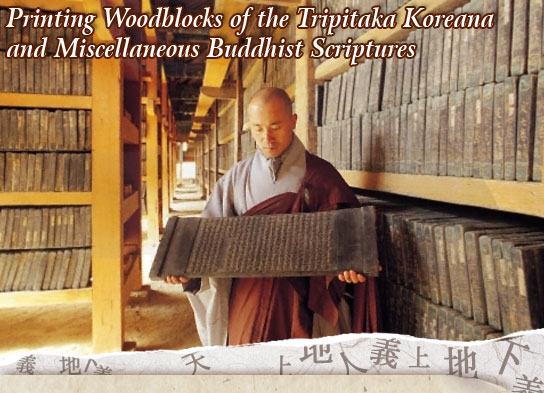 |
| The Eighty Thousand Wooden Printing Blocks of the Tripitaka Koreana |
| The Tripitaka Koreana (Goryeo Dynasty Tripitaka) are the world’s only extant collection of wooden printing blocks for the Buddhist scriptures that are written in classical Chinese. A complete collection of Buddhist scriptures, including Buddha’s discourses and sutras (rules of discipline) given in his lifetime and commentary by scholars in subsequent generations, is generally called a Tripitaka, and in Korean it is also called a Daejanggyeong (대장경). This Tripitaka is also known as the Goryeo Daejanggyeong (고려대장경) because it was carved during the Goryeo Dynasty (918~1392) or the Palman Daejanggyeong (Eighty Thousand Tripitaka, 팔만대장경), because of the number of the printing blocks in the collection. |
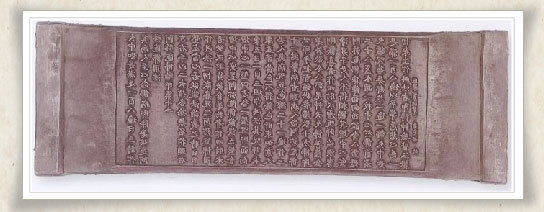 |
| The World’s Oldest and Most Complete Buddhist Scriptures |
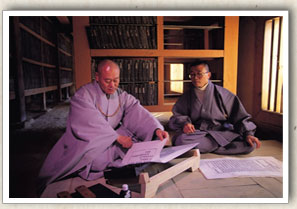 Stored in the buildings of Janggyeong Panjeon Hall in Haeinsa Temple in Gyeongsangnam-do province, the Tripitaka Koreana was completed by scribes between 1236 and 1251. In terms of its scholastic excellence (comparing, proofreading, adjusting, and arranging), it is recognized as the most comprehensive example of the woodblock printing technique in all known Buddhist scriptures of that time. Most of the subsequent Tripitakas produced in Japan, China, and Taiwan were based on the Goryeo Dynasty Tripitaka of Haeinsa Temple. In addition to the 81,258 wooden printing plates of the Tripitaka, the Janggyeong Panjeon Hall also stores 5,987 miscellaneous woodblocks of Buddhist texts, history, and scholastic research that were inscribed between 1098 and 1958. Stored in the buildings of Janggyeong Panjeon Hall in Haeinsa Temple in Gyeongsangnam-do province, the Tripitaka Koreana was completed by scribes between 1236 and 1251. In terms of its scholastic excellence (comparing, proofreading, adjusting, and arranging), it is recognized as the most comprehensive example of the woodblock printing technique in all known Buddhist scriptures of that time. Most of the subsequent Tripitakas produced in Japan, China, and Taiwan were based on the Goryeo Dynasty Tripitaka of Haeinsa Temple. In addition to the 81,258 wooden printing plates of the Tripitaka, the Janggyeong Panjeon Hall also stores 5,987 miscellaneous woodblocks of Buddhist texts, history, and scholastic research that were inscribed between 1098 and 1958. The Goryeo Dynasty Tripitaka is a priceless example of the early woodblock printing technique. Lacquered using sap from the lacquer tree, the woodblocks have excellent durability and can still print crisp copies 760 years after their creation. The total 87,000 woodblocks that make up the Goryeo Dynasty Tripitaka, as well as the miscellaneous woodblocks, record nearly the entire collection of Buddhist scriptures that exist in Asia. Based on the value of their content and the excellent state in which they have been preserved, they were listed on the UNESCO Memory of the World register in June 2007. |
| <Where to Find the Tripitaka Koreana and Miscellaneous Buddhist Woodblocks > |
| ☞Click here for information on Janggyeong Panjeon Hall in Haeinsa Temple ☞Click here for information on Haeinsa Temple in Hapcheon, Gyeongsangnam-do province ☞ Related Column: Reflections in a Calm Sea: Haeinsa Temple |
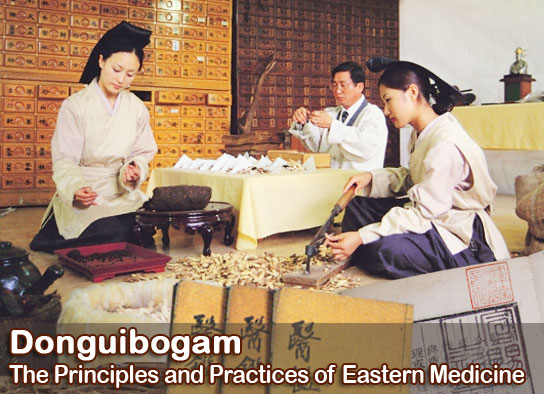 | ||||
| Encyclopedia of Oriental Medicine | ||||
| Donguibogam (Dong-ui-bo-gam), or “The Principles and Practices of Eastern Medicine”, was written by Heo Jun (1539~1615, also known as Uiseong Heo Jun) in the early 17th century, following an order from King Seonjo. Donguibogum is an encyclopedia of Oriental Medicine that presents not only the Korean medical theories of the time, but also medical theories that from all over East Asia. It has 25 volumes and was printed by wooden blocks. Donguibogam is easy to consult: each disease is described, followed by recommended methods of treatment. The texts below the headings were not written by the author himself, but were taken from other medical reference books. Donguibogam is very highly regarded and a great deal of its prestige stems from the author’s informative explanatory notes that accompany each text, as well as the detailed citations identifying the source of each of the texts contained in the 25 volumes. Donguibogam contains medical information from the Joseon Dynasty and from China, as well as popular methods of treatment handed down over the generations. The encyclopedia recommends medicinal ingredients readily available at the time and suggests preventive measures that can be taken before a disease breaks out. Furthermore, Donguibogam introduces foods that are beneficial for health, so it is still widely referred to in Korean cuisine. | ||||
| ||||
| Court Physician Heo Jun | ||||
After 16 years of research, Heo Jun was finally able to publish the Donguibogam, which he had first begun upon King Seonjo’s order. The book had a tremendous effect on the development of Oriental medicine in the Joseon era. In the 18th century, the book spread to Japan and China, where it was and is still recognized as one of the classics of Oriental medicine. Today, the Donguibogam still contributes greatly to the diffusion and development of East Asian traditional medicine. It has been reprinted 30 times in China and twice in Japan, and was partly translated into English by an American, Dr. Landis. It can be said that the Donguibogam has been widely used in the treatment of diseases for approximately 400 years. | ||||
| ||||
| Characteristics of Oriental Medicine | ||||
 Oriental Medicine differs from modern medicine in its holistic view of the human body. It believes that the body is an interconnected entity rather than a group of different organs. In Oriental Medicine, the human body is ‘a universe’ and there is a flow of energy among seemingly unrelated organs. This is viewed as a key factor when treating a disease. Due to this view, Oriental Medicine mainly focuses on treatment methods that help the body maintain a stable, constant condition. It is common for Korean people to drink an herbal concoction made by an Oriental medicine practitioner or to receive acupuncture when sick. Oriental Medicine differs from modern medicine in its holistic view of the human body. It believes that the body is an interconnected entity rather than a group of different organs. In Oriental Medicine, the human body is ‘a universe’ and there is a flow of energy among seemingly unrelated organs. This is viewed as a key factor when treating a disease. Due to this view, Oriental Medicine mainly focuses on treatment methods that help the body maintain a stable, constant condition. It is common for Korean people to drink an herbal concoction made by an Oriental medicine practitioner or to receive acupuncture when sick.Similar to the training for medical doctors practicing western medicine, becoming a doctor of Oriental medicine in Korea requires six years of specialized education at university level. Though 400 years have passed since its publication in 1613, Donguibogam has been well-preserved in its original form. It is still referred to in modern medical practice and serves as a basis for continued research. In recognition of its originality and historic importance, the first and complete edition of Donguibogam was listed on UNESCO’s Memory of the World Register in July 2009. These original editions of the Donguibogam are kept at the National Library of Korea (25 volumes / Treasure No. 1085) and the Academy of Korean Studies (25 volumes / Treasure No. 1085-2). | ||||
| ◆ Where to find the Donguibogam ☞ National Library of Korea ☞ Jangseogak of the Academy of Korean Studies ◆ Learn about Heo Jun and his other publications ☞ Heo Jun Museum ☞ Heo Jun Museum Official Site (Korean) ◆ Korean drama about Heo Jun ◆ Medical Tourism in Korea ☞ Oriental medicine tours ☞ Article: “New Initiatives for Medical Tourism in Seoul” ☞ Seoul Oriental Medicine Market | ||||
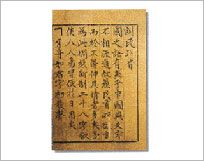
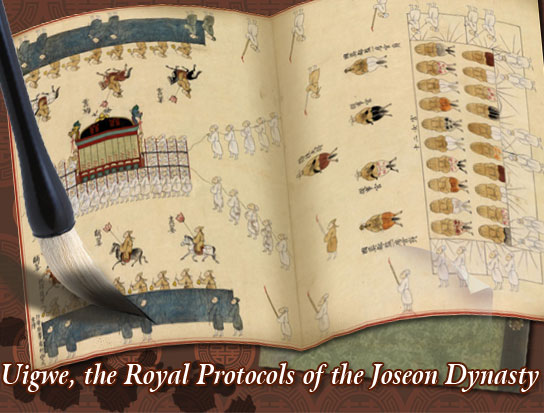
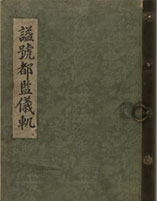 The Uigwe, which literally means “a model for rituals”, records through text and illustrations all the major state ceremonies and events of the Joseon Dynasty (1392~1910). This guide not only covers royal weddings, funerals, and banquets, but it also contains instructions for how to construct for royal buildings and burial sites, and guides for the cultural activities of the royal family, as well as the various other state events, which were systematically organized according to the traditions.
The Uigwe, which literally means “a model for rituals”, records through text and illustrations all the major state ceremonies and events of the Joseon Dynasty (1392~1910). This guide not only covers royal weddings, funerals, and banquets, but it also contains instructions for how to construct for royal buildings and burial sites, and guides for the cultural activities of the royal family, as well as the various other state events, which were systematically organized according to the traditions.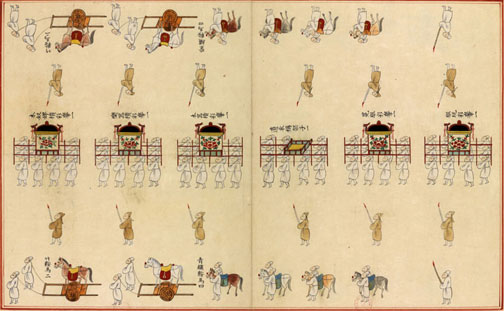
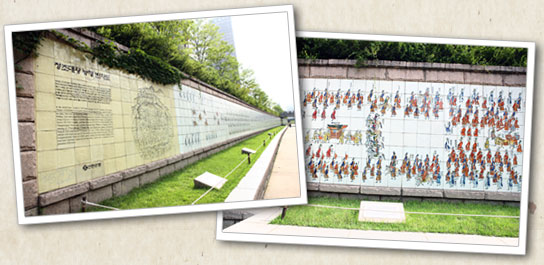
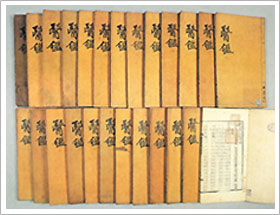
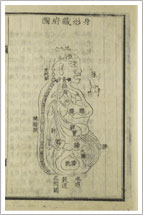
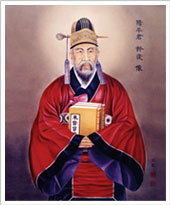
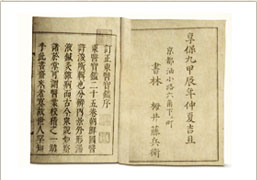
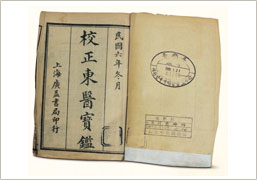
댓글 없음:
댓글 쓰기